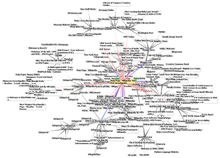Linking
Most web pages contain hyperlinks to other related pages and perhaps to downloadable files, source documents, definitions and other web resources (this Wikipedia article is full of hyperlinks). In the underlying HTML, a hyperlink looks like<a href="http://www.w3.org/History/19921103-hypertext/hypertext/WWW/">Early archive of the first Web site</a>

Graphic representation of a minute fraction of the WWW, demonstrating hyperlinks
information. Publication on the Internet created what Tim Berners-Lee first called the WorldWideWeb (in its original CamelCase, which was subsequently discarded) in November 1990.[3]
The hyperlink structure of the WWW is described by the webgraph: the nodes of the webgraph correspond to the web pages (or URLs) the directed edges between them to the hyperlinks.
Over time, many web resources pointed to by hyperlinks disappear, relocate, or are replaced with different content. This makes hyperlinks obsolete, a phenomenon referred to in some circles as link rot and the hyperlinks affected by it are often called dead links. The ephemeral nature of the Web has prompted many efforts to archive web sites. The Internet Archive, active since 1996, is one of the best-known efforts.
[edit] Dynamic updates of web pages
Main article: Ajax (programming)
JavaScript is a scripting language that was initially developed in 1995 by Brendan Eich, then of Netscape, for use within web pages.[25] The standardized version is ECMAScript.[25] To overcome some of the limitations of the page-by-page model described above, some web applications also use Ajax (asynchronous JavaScript and XML). JavaScript is delivered with the page that can make additional HTTP requests to the server, either in response to user actions such as mouse-clicks or based on lapsed time. The server's responses are used to modify the current page rather than creating a new page with each response. Thus, the server must provide only limited, incremental information. Since multiple Ajax requests can be handled at the same time, users can interact with a page even while data is being retrieved. Some web applications regularly poll the server to ask whether new information is available.[26]
No comments:
Post a Comment